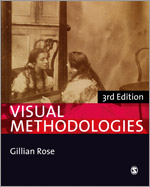
Visual Methodologies An Introduction to Researching with Visual Materials
- Gillian Rose - University of Oxford, UK, Open University, UK
| Format | Published Date | ISBN | Price |
|---|
Gillian Rose
My research interests lie broadly within the field of visual culture. I'm interested in visuality as a kind of practice, done by human subjects in collaboration with different kinds of objects and technologies.
One long-term project, which resulted in a book from Ashgate Press in 2010, looked at family photos. I approached family snaps by thinking of them as objects embedded in a wide range of practices. I interviewed women with young children about their photos, and also looked at the politics and ethics of family snaps moving into more public arenas of display when the people they picture are the victims of violence. The book explores the different 'politics of sentiment' in which family snaps participate in both their domestic spaces in the public space of the contemporary mass media.
Other work is extending my interest in subjectivities, space and visual practices by exploring experiences of designed urban spaces. I completed an ESRC-funded project on this theme with Dr Monica Degen at Brunel University in 2009, in which we compared how people experienced two rather different town centres: Milton Keynes and Bedford. Monica Degen, Clare Melhuish and I started a new ESRC-funded project in the autumn of 2011. 'Architectural atmospheres, branding and the social: the role of digital visualizing technologies in contemporary architectural practice' was a two-year ethnographic study of how digital visualizing technologies are being used by architects in a number of architects' studio in London.
I'm also interested in more innovative ways to produce social science research, especially using visual materials. I was involved in organising the ESRC Seminar Series 'Visual Dialogues: New Agendas in Inequalities Research' (2010-2012). Please visit the 'Visual Dialogues: New Agendas in Inequalities Research' for more details. I'm also a member of the OpenSpace Research Centre.